This locality is one of the best areas in the
Central Precordillera to watch lower Ordovician carbonate succession of the
San Juan Formation, and the overlying upper Ashgill–Silurian deposits of the
Tucunuco Group, mainly of the lower La Chilca Formation. In fact, this section
is significant because it includes the Ordovician–Silurian boundary. The erosional
unconformity at the base of the La Chilca Formation, results from diastrophic,
glaci–eustatic and eustatic events through the Late Ordovician (Rolleri, 1947;
Baldis et al., 1984; Astini, 1991a, 1992b; Peralta, 1994) in this locality.
The Talacasto Canyon offers a spectacular outcrop of an east–vergent anticline
with a complex folded core affecting the San Juan limestones (see Figures 1
and 2 for location).
San Juan Formation (Kobayashi, 1937; Keller et al., 1994)
The name of San Juan Formation is derived from
the Province of San Juan and was originally used for the whole succession of
platform carbonates. Its type section is exposed in the Cerro La Silla where
a thickness of approximately 350 m was determined (Keller et al., 1994).
The lower boundary is marked by the appearance of abundant open marine fauna,
whereas the upper boundary is given by an alternation of black shales and platy
marlstones or by graptolitic black shales, the Gualcamayo or Los Azules Formations,
respectively. Abundant fossils can be recovered from this unit, among which
sponges, brachiopods, echinoids, trilobites, gastropods, bryozoans and nautiloids
are the most frequent. Its age ranges from the latest Tremadoc (mid–upper Ibexian)
to early Llanvirn (early Whiterockian), although its upper boundary is regionally
diachronous, being late Arenig in the northern Precordillera and early Llanvirn
in the southern–central Precordillera as determined by conodonts (Hünicken,
1985; Lehnert, 1995a; Albanesi et al., 1998).
Lithologically it is mainly composed of limestones
(wackestones and packstones) and minor marlstones near the top. Yellowish to
brownish dolomites are almost absent, being related to pressure solution or
burrow fillings. A dramatic change in widespread muddy fossiliferous carbonates
is represented in the Precordillera by the lower section of the San Juan Formation
of late Tremadoc and early Arenig age, which is composed by open shelf subtidal
limestones of thin– to medium–bedded burrowed skeletal wackestones and packstones
with thin intebeddings of coarse–grained storm deposits and widespread metazoan
buildups (sponges, receptaculitid Calathium, Girvanella, and microbial
structures) associated with grainstones (Carrera, 1991; Cañas & Keller,
1993; Cañas & Carrera, 1993). By then, the Precordillera platform had many
of the attributes of an epeiric sea (sensu Shaw, 1964). The massive limestones
of the middle part of the San Juan Formation, which comprises the Monorthis
Zone (Herrera & Benedetto, 1991) with scarce fauna, are capped by stromatoporid
and sponge–algal–stromatoporoid reefs, typical of shallow warm waters (Cañas
& Keller, 1993). The upper stylo–nodular wackestones contain characteristic
platform faunas of the San Juan Formation (Ahtiella Zone, Herrera &
Benedetto, 1991). Kolata et al. (1994) and Huff et al. (1995)
have discovered horizons of K–bentonites for an interval of several meters through
the top of this unit, in several sections of the Precordillera.
Imbricated thrusts of the San Juan limestones
show excellent outcrops of the fossiliferous upper levels of the San Juan Formation
(Ahtiella Zone) and the Silurian Tucunuco Group (La Chilca and Los Espejos
formations), which bear the typical Clarkeia fauna (a classical locality
for fossil collection). Sponges include: Patellispongia argentina, P. occulata,
Archaeoscyphia tenuis, A. Anulata, A. Typicalis, A. Minfanensis, Hudsonospongia
cyclostoma, Anthaspidella? Annulata Rhopalocoelia clarkei, among others
(Carrera, 1994a, b; Beresi & Rigby, 1993). Brachiopods include: Paralenothis
talacastensis, Petroria rugosa elevata, Ahtiella argentina, Sajuanella sp.,
Camarella sp., Idiostrophia n. sp., Rugostrophia sp.,
among others. Trilobites include: Annamitella forteyi, Basillicus (Basiliella)
n.sp., Illaemus ssp. Ampyx sp., Acanthoparyphinae gen. et
sp. indet. Rostroconchids as Talacastella herrerai, and abundant gastropods,
nautiloids, and bryozoans (Hallopora sp. and Amplexopora sp.,
Carrera, 1994a).
Nearby Ancha Creek the highly fossiliferous
upper part of the San Juan Formation (lower Llanvirn) crops out. On the road
between the Talacasto Baths and the Ancha Creek a block of the San Juan Formation,
about 40 m thick, intercalates K–bentonites. Same block records the first appearance
of Protoprioniodus aranda Cooper and Texania heligma Pohler, which
are key species to define the Lower – Middle Ordovician Series boundary, as
it is proposed for the Niquivil section, Precordillera of San Juan (Albanesi
et al., 2003). These data and the presence of K–bentonites, which allow
for the radiometric dating of these levels (Baldo et al., 2003), make
the profile feasible as auxiliary section for the referred boundary. In these
strata, the oldest known scolecodonts from South America were recorded (Eriksson
et al., 2002).
Outcrops showing the unconformity that separates
Lower Ordovician limestones and the uppermost Ordovician and Silurian clastics
of the La Chilca Formation are located to the east of the Talacasto anticline.
Cuerda et al. (1988) recognized three assemblages: The Glyptograptus
persculptus Zone (0.55 m above the conglomerate): Climacograptus angustus,
Glyptograptus persultus, Pseudoclimacrograptus robustus, Climacograptus cf.
medius and C. normalis. A suspected Parakidograptus acuminatus Zone
(0.60 to 1.60 m from the bottom): Climacograptus angustus, C. robustus, C.
cf. medius, C. normales, C. acceptus, C. rectangularis,? Glyptograptus
maderni, and Rhaphidograptus sp. An interval that probably corresponds
to the Atavograptus atavus Zone (1.60 m to 3.70 m) includes the following
taxa: Climacograptus angustus, C. cf. medius, C.
normalis, C. rectangularis, Lagarograptus praeacinaces,
Paraclimacograptus? sp. nov., ?Cystograptus sp., Clinoclimacograptus
sp. and Talacastograptus leanza (See Figures, 4, 13).
Ancha Creek
The unconformable contact of the San Juan Formation
with Silurian deposits (La Chilca Formation) is well–exposed to about 5 km south
of road, on the eastern margin of Ancha Creek. Aside the road we will visit
outcrops of the middle and upper part of the Los Espejos Formation. The siliciclastic
Silurian sequence is interrupted by a thrust of the San Juan Formation. In the
basal part of the Silurian platform deposits it is possible to identify the
Nereites ichnofacies and a poorly diversified brachiopod fauna (Harringtonina
acutiplicata and Australina jachalensis) related to low oxygen contents
in the basin (Sánchez et al., 1993). The interbedded coquinas in the
middle–upper part of these outcrops yield a diverse fauna of brachiopods, gastropods,
trilobites, tentaculitids, conodonts, ostracods, and graptolites. Monograptus
uncinatus notouncinatus Cuerda and Saetograptus argentinus (Cuerda)
(see Figures 5, 12) are the only graptolites registered at present, which were
referred to an early Ludlow age by Cuerda (1969, 1971). The finding of conodonts
from the Kokelella variabilis variabilis Zone verifies this age for the
bearer levels (Albanesi, in progress; cf., Hünicken and Sarmiento, 1988).
The conodont fauna consists of Kokelella v. variabilis Walliser, Pseudooneotodus
beckmanni Bischoff & Sannemann, Panderodus unicostatus Branson
& Mehl, Oulodus siluricus (Branson & Mehl), Ozarkodina confluence
(Branson & Mehl), Ozarkodina excavata excavata (Branson &
Mehl), and Coryssognathus dubius (Rhodes), restricted to the Gorstian
Stage of the Ludlow Series (K. v. variabilis Zone of Sardinia, Italy,
by Corradini & Serpagli, 1999) (see Figure 11).
The objetive of this stop is to visit the Silurian
and Devonian platform deposits, of the Tucunuco and Gualilán groups, respectively.
They form a sedimentary cycle, unconformity–bounded, which starts in the Late
Ashgill (Hirnantian) to end in the Middle Devonian, according to the biostragraphic
record. Each group consists of two formations, which show shallowing upward
trends. The Tucunuco Group (Late Ashgillian – Silurian) (Cuerda, 1969) includes
the Silurian units outcropping in the Central Precordillera, ranging in age
from the late Ashgill (Hirnantian) until Pridoli to Lochkovian (see Figure 5).
From bottom to top it includes the La Chilca and the Los Espejos Formation,
both yielding important Malvinokaffric faunas. The La Chilca Formation is sand
dominated, whereas the Los Espejos is mixed to mud dominated (Astini, 1991b;
Astini & Piovano, 1992). Toward the south, this unit receives the name of
Tambolar Formation in the San Juan River outcrops, where it has only around
67 m thick in its type locality, at Portezuelo del Tambolar Pass, with similar
shallowing upward trend.
The La Chilca Formation (Cuerda, 1969) is composed
mainly by yellowish sandstones with thorough low–angle cross–stratification
and frequently amalgamated beds. Siltstone partings and minor fossil concentrations
are present is some localities. The type section of this unit is located in
the Cerro La Chilca, where it overlies the Don Braulio Formation (Upper Ordovician)
and is conformably overlain by the Los Espejos Formation. Its thickness varies
from 25 to 85 m in different localities. Everywhere, a basal chert conglomerate
seldom mixed with a rich graptolite fauna develops immediately on top, where
Normalograptus persculptus has been found, indicating a latest Ordovician
age for this basal part. In the Talacasto area, Cuerda et al. (1988)
recognized the G. persculptus, and probably the Parakidograptus acuminatus
and Atavograptus atavus zones. In the western flank of Cerro del Fuerte,
graptolite assemblages indicate the N. persculptus Zone and other association
that is referred to the atavus to triangulatus zones inclusive
(Rickards et al., 1996). Facies arrangement and upward–thickening trends
indicate an increasing shallowing toward the top, with significant influence
of storms modelling the bottom substrate.
The name of the Los Espejos Formation (Cuerda,
1969) is derived from the shiny surfaces of fine–grained sandstones embedded
in olive green silstones of this unit. It is characterized by a rich brachiopod
content, which is commonly concentrated in coquinas (Sánchez et al.,
1991). Its thickness varies from approximately 280 m in the area of Talacasto
to more than 500 m in the area of Cerro del Fuerte near Jáchal. This unit is
Ludlow to Pridoli in age based on brachiopods, graptolites and achritarchs.
In the region of Cerro del Fuerte, it passes in transition into the lowermost
Devonian (Benedetto et al., 1992). This unit exhibits frequent symmetric
ripple marks and hummocky surfaces toward the top and abundant trace fossils.
Increasing bed thickness, as well as higher energy structures and trace fossils
demonstrate upward shallowing trends. In the Los Espejos Formation three associations
characterize the following environments: muddly shelf with no influence of wave
action, inner shelf under storm activity, and storm–dominated shoreface to offshore
transition (Astini & Piovano, 1992). In the Silurian Clarkeia fauna,
the following brachiopods are common: Australina jachalensis, Harringtonina
acutiplicata, Leangella (Leangella) mutabilis, Dedzetina? silurica, Amosina
sp., Leptaena spp., Coelospira sp., Clarkeia sp., Isorthis
sp. Castellaroina fascifer (Benedetto et al., 1992). Nereites,
Zoophycos and Cruziana ichnofacies are present in the Silurian beds.
The Gualilán Group (Devonian) (Baldis, 1975)
takes its name from the type locality in the Central Precordillera (the Gualilán
depression). It includes the Talacasto and the Punta Negra formations, both
of them siliciclastic and Devonian in age. These units are characterized by
their content of typical Malvinokaffric faunas and incarbonated plant fossil
remains. Very rich micas, specially moscovites, and stable and unstable heavy
minerals show an increasing influence of their provenance from metamorphic rocks.
The Poblete Creek is the type section of the Gualilán Group (Talacasto and Punta
Negra formations), which is considered a good fossil locality for the Lower
Devonian with typical Malvinokafric faunas.
The Talacasto Creek is the type locality for
the Talacasto Formation (Padula et al., 1967). This unit mostly crops
out between the Jáchal River area and the River San Juan area, in the Central
Precordillera setting, with variable thickness, and is characterized by its
pale greenish to gray colors. Toward the south, its thickness is about 100 m,
whereas to the north it is more than 700 m. The gap that separates this unit
from the Silurian rocks dramatically decreases toward the northeast. Moreover,
in the Cerro del Fuerte locality (to the southeast of Jáchal) it overlies the
Silurian strata, where it starts with a thin basal conglomerate that consists
of iron oolites and phosphate nodules. It is mainly composed of muddy bioturbated
sandstone and silstones with minor thin–bedded graded and laminated sandstone
layers with wave reworking on tops. Brachiopod and trilobite fossil remains
are common especially in marly nodules which occur in the middle to upper section.
Trilobites include: Parabouleia eldredgei, Tormesiscus hildae, Tarijactinoides
jarcaensis, Francovichia sp., Harpidella sp., Burmesteria (Burmesteria)
hercheli. Brachiopods include: Babinia cf. B. parvula, Pacificocoelia
cf. nunezi, Metaplasi baldisi, Sanjuanetes andina, Australospirifer antarticus,
Australocoelia tourteloti, Protoleptostrophia cocinna, Orbiculoidea callis,
Spinoplasia pobletensis, among others. These are associated with abundant
bivalves, conulariids, hyolitids, and plant fragments.
Among the composite ichnofabrics Zoophycos,
Arenicolites, Chondrites, Phycosiphon, Scalarituba, and Paleophycus,
among others, are the more common and diagnostic traces. Its important brachiopod
faunas allow assigning the Talacasto Formation to the Lower Devonian and to
the Malvinokaffric realm (Herrera, 1993). This unit has been interpreted as
a muddy shelf sequence (Astini, 1991b) with periodically influences of storm
events. Facies trends closely resemble across–shelf trends on modern shelves
supplied by muddy rivers, suggesting that the processes were similar. The general
trend shows a gradual shallowing to the middle part and an increase of depth
toward the top, where a condensed section separates it from the overlying Punta
Negra Formation.
The Punta Negra Formation (Bracaccini, 1950)
is characterized by its great thickness (more than 700 m) and coarse grain,
graded sandstones with profuse current marks and trace fossils of the Cruziana
Ichnofacies at their bases. Thick–bedded, coarse to medium grain sandstone beds
show upward thickening and thinning trends of 5 to 10 m thick, which are interbedded
with finely laminated siltstones and sandstones with ripple marks. These are
interpreted as channel and lobe sequences, and interlobe fines, respectively.
This unit transitionally overlies the Talacasto Formation. To the top is covered
through a regional erosive unconformity by upper Paleozoic glacial rocks and
red beds. Very few fossils have been found up to date, except for the plant
remains and scarce inarticulate and articulate brachiopod remains which do not
show much difference with those found in the Talacasto Formation. Its age is
tentatively established as mid Devonian. According to their facies, the Punta
Negra Formation could represent either turbidite fan deposits or prograding
deltaic systems developed on a wide ramp margin. Because of its continuity with
the Talacasto Formation, the second alternative is more probable. Glacial paleovalley
carved into the Devonian (Punta Negra Fm.), which are represented by resedimented
glaciolacustrine coarse conglomerates and pebbly sandstones with minor rippled
sandstones with dropstones (Martinez & Astini, 1992). We will observe the
erosive contacts to both sides of the glacial trough and the onlapping relationships
of the Carboniferous beds onto the Devonian paleorelief.
The stratigraphy in the Western Precordillera
is much simpler (Astini, 1991a, 1992a) although the complex structure and the
very low–grade metamorphism complicate the general framework. The three main
units from bottom to top are the Los Sombreros, Yerba Loca, and the Alcaparrosa
formations, for which several names are common. An equivalent for the Yerba
Loca Fm. in the central Precordillera is the Sierra de La Invernada Formation.
The thin–skinned thrust belt that characterizes the Precordillera can be appreciated
along the Jáchal River canyon. Its main characteristic is the exposure of Lower
Paleozoic rocks involving Ordovician, Silurian, and Devonian clastics, separated
by longitudinal narrow valleys, which in turn are filled with Tertiary foreland
deposits and Quaternary alluviums. The Ordovician clastics show the complete
stratigraphy of the western tectofacies in a slope to basinal setting.
Four to six major west dipping Cenozoic thrusts
account for the great shortening observed in this region (90 to 95 km according
to Allmendinger et al., 1990). The important Neogene to Quaternary deformation
in the Precordillera is superimposed to the Paleozoic tectonism. This can be
observed in the Jáchal River, particularly in the western tectofacies. Evidences
in favour of a Mid Ordovician tectonism are mainly sedimentological and are
given by the olistoliths represented in the Lower Ordovician Los Sombreros Fm.,
the thick turbidite succession of the Middle Ordovician Yerba Loca Fm., and
the mafic lava flows preserved in the Upper Ordovician Alcaparrosa Fm. By contrast,
the age of the metamorphism that affected the western tectofacies has been dated
as Silurian to early Devonian (Buggisch & von Gosen, 1994).
The Los Sombreros Formation (Cuerda et al.,
1983) (Figure 9) is a sedimentary mélange with abundant carbonate allochthonous
blocks and debris flows with mixed Cambrian to Lower Ordovician (up to Arenig)
blocks in a fine–grained siliciclastic matrix with well developed slaty cleavage.
This unit, about 400 m thick, includes olistoliths over 1 km length, and is
affected by a very low–grade metamorphism (conodont CAI 5). According to the
autochthonous faunal content (graptolites and conodonts) its age is restricted
to the late Arenig–early Llanvirn interval (Ortega et al., 1991; Benedetto
& Vaccari, 1992, Albanesi, unpubl. coll.). The basal olistostrome of the
Los Sombreros Formation is composed of a variety of carbonate blocks ranging
in age from Lower Cambrian to Lower Ordovician (Benedetto et al., 1986,
Benedetto & Vaccari, 1992) embedded in a muddy matrix that is affected by
slaty cleavaje and very low grade metamorphism. It constitutes the olistostrome
levels and breccias observed in the basal part of the Los Sombreros Fm. outcropping
in the Jáchal River section. Resedimented quartz conglomerates, chert pebbles,
subfeldespathic and quartzose turbidites, shales, and hemipelagites, together
with the olistostromes, are the dominant lithologies.
The so–called "Los Túneles" olistolith
is a huge carbonate slab in the Los Sombreros Formation with Middle Cambrian
trilobites, which is conformably overlain by resedimented carbonates with early
Middle Ordovician conodonts (Paraistodus originalis and Pteracontiodus
cryptodens, among others) (Benedetto & Vaccari, 1992; Albanesi, unpubl.
coll.). Faulted contact with the Yerba Loca Fm. with graptolites of the Paraglossograptus
tentaculatus Zone and hybrid arenites with microfossils like Nuia sp.
(common in the upper section of the San Juan Fm.) indicating a Llanvirn or early
Whiterock age. The carbonate slab is composed of mostly dark hemipelagic fine–grained
evenly–stratified limestones, typical of outer platform to slope environments.
They contain a well preserved trilobite fauna (Vaccari & Bordonaro, 1993)
(see Figure 9).
A west vergent folded succession of the Yerba
Loca Formation (Furque, 1963) can be observed on the left margin of the Jáchal
River. It is a typical turbidite succession (Astini, 1988a,b) of over 1000 m
thick, intruded by mafic–ultramafic sills and dikes. Although affected by very
low–grade metamorphism, intense cleavage and kinking, original sedimentary features
can be recognized in several sections. The lithologic association is composed
by fine–grained turbidites, coarse–grained turbidites and subordinated conglomerates,
and hemipelagites. Facies sequences characterize sandy turbidite lobes, shallow
distributary channel systems and interlobe deposits. The sandstone textures
are predominantly subwackes and arenites of sublithic to subfeldespatic composition,
falling into the sublithic to lithic field in ternary diagrams. Petrofacies
analysis (Astini, 1991a) indicates a recycled orogen provenance and, to a lesser
extent, dissected arc and continental block provenances (75% Qz, 10% Fd., 15
% Lithics, 0.05% volcanics, 9% sedimentary, 3% metamorphics, and 3% polycristaline
quartz). An important feature of this unit is the presence of mafic pillow lavas
and ultramafic columnar jointed sills, which outcrop in the westernmost Precordillera.
The rock assemblage has been interpreted as part of an ophiolite complex by
Ramos et al. (1984, 1986).
The age of this formation ranges from the late
Arenig to the early Caradoc (Ortega et al., 1991; Albanesi et al.,
1995). A preliminary conodont zonation considers the Lenodus variabilis,
Eoplacognatus suecicus, and Pygodus serra zones for the eastern
section (Ancaucha and Cerro Alto de Mayo). A graptolite assemblage suggesting
the Undulograptus austrodentatus – Undulograptus dentatus zones (Paraglossograptus
tentaculatus Zone sensu Ortega et al., 1991) comprise Ptilograptus
sp., Cryptograptus antennarius, Isograptus caduceus caduceus, Tetragraptus
sp., Undulograptus sp. cf. U. dentatus, and Holmograptus
serpens (see Figure 16). The green phyllites of the upper part of
the formation (western section) contain scarce and poorly preserved graptolites
of the Nemagraptus gracilis fauna in the Cuesta del Viento locality (Blasco
and Ramos, 1976). Bearer strata are referred to an early Caradoc age; however,
it is not possible to recognize which of both, the Nemagraptus gracilis or
the Climacograptus bicornis Zone is present.
A new graptolite association includes Corynoides
calicularis, Corynites? sp., Cryptograptus insectiformis, Dicellograptus
flexuosus, Phormograptus sooneri, Climacograptus caudatus, Orthograpthus sp.
cf. O. quadrimucronatus, Rectograptus sp. cf. R. amplexicaulis,
Orthoretiolites sp. cf. O. hami robustus, among others, was mentioned
for the Yerba Loca Formation exposures at El Tigre Range (Brussa, 1995; Brussa
et al., 1999). It could be equivalent to the Dicranograptus clingani and
Pleurograptus linearis zones of Scotland, and Climacograptus spiniferous
and Glyptograptus pigmaeus zones of North America (Eastonian, Ea2
– Ea3 of the Australian scheme).
Lower Upper Ordovician graptolitic black and
gray shales with mafic and ultramafic sills, exposed in the Cuesta del Viento
section, have been referred by Astini et al. (1995) to the Alcaparrosa
Formation (Harrington, 1957), which are included in this Field Guide in the
Yerba Loca Formation. A west vergent folded of this succession can be observed
on the left margin of the Jáchal River. We will see several flows with pillow
lavas and columnar jointed sills. Graptolites in black shales represent to the
Nemagraptus gracilis Zone (Blasco & Ramos, 1976). The rock assemablage
has been interpreted as part of an ophiolite complex by Ramos et al.
(1984, 1986). This formation is composed mainly of alternating dark gray to
black graptolitic shales, minor lithic graywackes, and quartzose sandstone bodies.
An important feature of this unit is the presence of mafic pillow lavas and
ultramafic sills, which outcrop in the westernmost Precordillera. According
to the graptolite fauna the age of this unit could be assigned to the early
Late Ordovician due to the presence of Nemagraptus gracilis (Blasco &
Ramos, 1976). New findings by Ortega et al. (1991) and Brussa (1994) recently
moved its age up to the mid Late Ordovician.
Last stop will be the Pachimoco area (Figure
10) where folded Silurian strata of the Los Espejos Formation will be seen.
This is a classical fossiliferous locality for the Silurian of the Central Precordillera.
It is noteworthy the absence of the La Chilca Formation in this locality.
Albanesi, G.L., Carrera,
M.G., Cañas, F. & Saltzman M. 2003. The Niquivil Section, Precordillera
of San Juan, Argentina, proposed gssp for the lower / middle ordovician
boundary. In: Albanesi, G.L., Beresi, M.S. and Peralta, S.H. (Eds.),
Proceedings 9th International
Symposium on the Ordovician System. Serie
Correlación Geológica, Tucumán, 17.
Albanesi, G. L., Hünicken, M. A. & Barnes,
C.R., 1998. Bioestratigrafía de conodontes de las secuencias ordovícicas del
cerro Potrerillos, Precordillera Central de San Juan, República Argentina.
In: Hünicken, M. A. (ed.), Bioestratigrafía, Biofacies y Tafonomía
de conodontes de las secuencias ordovícicas del cerro Potrerillo, Precordillera
Central de San Juan, República Argentina. Actas de la Academia Nacional
de Ciencias, v. 12: 7–72. Córdoba.
Albanesi, G., Ortega , G. & Hünicken,
M., 1995, Conodontes y graptolitos de la Formación Yerba Loca (Arenigiano–Llandeiliano)
en las quebradas de Ancaucha y El Divisadero, Precordillera de San Juan, Argentina:
Boletín de la Academia Nacional de Ciencias, v. 60 (3–4), p. 365–400.
Allmendinger, R.W., Figueroa, D., Snyder,
D., Beer, J., Mpodozis, C. & Isacks, B., 1990, Foreland shortening and
crustal balancing in the Andes at 30º S Latitude: Tectonics, v. 9, p. 789–809.
Astini, R.A., 1988a, Consideraciones sedimentológicas
de la Formación Yerba Loca, Ordovícico de la Precordillera Argentina: 2º Reunión
Argentina de Sedimentología, Buenos Aires, v. 1, p. 11–15.
Astini, R.A., 1988b, Yerba Loca Formation,
an Ordovician clastic wedge in Western Argentina: 5 International Symposium
on Ordovician System, Nwefounland, Abstracts, p.3.
Astini, R.A., 1991a, Paleoambientes sedimentarios
y secuencias depositacionales del Ordovícico clástico de la Precordillera
Argentina (Ph.D. thesis): Córdoba, Universidad Nacional de Córdoba, 851 p.
Astini, R.A., 1991b, Sedimentología de la
Formación Talacasto: plataforma fangosa del Devónico precordillerano, Provincia
de San Juan: Revista de la Asociación Geológica Argentina, v. 46, p. 277–294.
Astini, R.A., 1992a, Tectofacies ordovícicas
y evolución de la cuenca eopaleozoica de la Precordillera Argentina: Estudios
Geológicos, v. 48, p. 315–327.
Astini, R.A., 1992b, Origin and implications
of a Lower Paleozoic (Late Ordovician to Early Silurian) unconformity on the
Precordillera basin of Western Argentina, in Thiry, M. ed., Paleoweathering
records and paleosurfaces "Landscape reconstruction": 2º International
Meeting, Project 317 (IGCP), La Plata, Abstracts, p. 6–7.
Astini, R.A., 1993, Facies glacigénicas del
Ordovícico tardío (Hirnantiense), Precordillera Argentina: Boletín de la Real
Sociedad Española de Historia Natural, v. 88, p. 137–149.
Astini, R.A., Benedetto, J.L. & Vaccari,
N.E., 1995, The Early Paleozoic evolution of the Argentine Precordillera as
a Laurentian rifted, drifted, and collided terrane: A geodynamic model: Geological
Society of America Bulletin, v. 107, p. 235–273.
Astini, R.A. & Piovano, E. L., 1992, Facies
de plataforma terrígena del Silúrico de la Precordillera sanjuanina: Revista
de la Asociación Geológica Argentina, v. 47, p. 99–110.
Astini, R. A., Vaccari, N. E, Cañas, F. L.,
Benedetto, J. L., Brusa, E. D. & Carrera, M. G., 1995. Field Guide 2:
Cerro La Silla Cambro–Ordovician carbonates, Ordovician clastics of the Jáchal
River & Talacasto Ordovician–Silurian boundary. Pernrose Conference,
Geological Society of America–CONICET, Octubre 17, San Juan, Argentina.
Baldis, B.A., 1975, El Devónico Inferior de
la Precordillera Central, Parte 1. Estratigrafía: Revista de la Asociación
Geológica Argentina, v.30 (1): p. 53–83.
Baldis, B. A. & Chebli, G., 1969. Estructura
profunda del sector central de la Precordillera sanjuanina. IV Jornadas Geológicas
Argentinas, Actas I: 47–66.
Baldis, B.A., Beresi, M., Bordonaro, O. &
Vaca, A., 1982. Síntesis evolutiva de la Precordillera Argentina. V Congreso
Latinoamericano de Geología, Actas VI: 399–445. Buenos Aires.
Baldis, B.A., Bordonaro, O., Beresi, M. &
Uliarte, E., 1981, Zona de dispersión estromatolítica en la secuencia calcáreo
dolomítica del Paleozoico Inferior de San Juan: VIII Congreso Geológico Argentino,
v. 1, p. 419–434.
Baldis, B. A., Peralta, S. H. & Uliarte,
E. R., 1984. Geología de la Quebrada Ancha y sus alrededores en el área de
Talacasto, Precordillera sanjuanina. IX Congreso Geológico Argentino, Actas
4: 233–245. S.an Carlos de Bariloche, Provincia Rio Negro.
Baldo, E.G., Fanning, C.M.,
Rapela, C.W., Pankhurst, R.J., Casquet, C. & Galindo, C. 2003. U/Pb shrimp
dating of rhyolite volcanism in the Famatinian belt and k–bentonites in the
Precordillera. In: Albanesi, G.L., Beresi, M.S. and Peralta, S.H. (Eds.),
Proceedings 9th International
Symposium on the Ordovician System. Serie
Correlación Geológica, Tucumán, 17.
Beer, J.A., Allmendinger, R.W., Figueroa,
D.A. & Jordan, T.E., 1990, Seismic stratigraphy of a Neogene piggi–back
basin, Argentina: American Association Petroleum Geologists Bulletin, v. 74,
p. 1183–1202.
Benedetto, J.L., Vaccari, N.E. & Herrera,
Z.A., 1986, El hallazgo de rocas cámbricas fosilíferas al Oeste de Jáchal,
Provincia de San Juan: IV Congreso Argentino de Paleontología y Bioestratigrafía,
v. 1: p. 29–30.
Benedetto, J.L. & Vaccari, N.E., 1992,
Significado estratigráfico y tectónico de los complejos de bloques cambro–ordovícicos
resedimentados de la Precordillera Occidental, Argentina: Estudios Geológicos,
v. 48, p. 305–313.
Benedetto, J.L., Racheboeuf, P., Herrera,
A., Brussa, E. & Toro, B., 1992, Brachiopodes et biostratigraphie de la
Formacion de Los Espejos, Siluro–Dévonien de la Precordillere (NW Argentine):
Geobios, v. 25 (5), p. 599–637.
Bercowski, F., Keller, M. & Bordonaro,
O., 1990, Litofacies de la Formación La Laja (Cámbrico) en la Sierra Chica
de Zonda, Precordillera sanjuanina, Argentina: Tercera Reunión Argentina de
Sedimentología, v. 1, p. 31–36.
Beresi, M.S. & Rigby, J.K., 1993, The
Lower Ordovician sponges of San Juan, Argentina: Bringham Young University
Geology Studies, v. 39, p. 1–64.
Blasco, G. & Ramos, V., 1976, Graptolitos
caradocianos de la Formación Yerba Loca y del cerro La Chilca, Provincia de
San Juan: Ameghiniana, v. 13 (3–4), p. 312–329.
Bordonaro, O., 1980, El Cámbrico en la quebrada
de Zonda, Provincia de San Juan: III Congreso Argentino de Paleontología y
Bioestratigrafía , V. I, p. 7–11
Borello, A.V., 1962, Caliza La Laja (Cámbrico
Medio de San Juan): Noticias y Comunicaciones de Investigaciones Científicas,
La Plata, v. 2, p. 3–8.
Braccacini, O., 1950, Observaciones estratigráficas
de la Precordillera sanjuanina: Revista de la Asociación Geológica Argentina,
v. 5, p. 5–14.
Brussa, E.D., 1994, Las graptofaunas ordovícicas
del sector central de la Precordillera Occidental sanjuanina, Argentina: (Ph.D.
thesis), Córdoba, Universidad Nacional de Córdoba, 323 p.
Brussa, E.D., 1995, Preliminary analysis of
the distribution of Early Ordovician graptolites from the Argentine Precordillera,
in: Cooper, J., Droser, M. and Finney, S., (Eds.), Ordovician Odyssey: Short
Papers for the Seventh International Symposium on the Ordovician System: The
Pacific Section Society for Sedimentary Geology (SEPM), v. 77, p. 185–188.
Brussa, E. D., 1996. Graptolitos del Arengiano
tardío–Llanvirniano de la Formación Sierra de la Invernada, Precordillera
Occidental sanjuanina, Argentina. Parte I. Ameghiniana, 34: 357–372.
Buenos Aires.
Brussa, E.D. 1997a. Graptolitos del Arenigiano
tardío –Llanvirniano de la Formación Sierra de La Formación Sierra de la Invernada,
Precordillera Occidental sanjuanina, Argentina. Parte I. Ameghiniana,
34 (3): 357–372.
Brussa, E.D. 1997b. Graptolitos del Arenigiano
tardío –Llanvirniano de la Formación Sierra de La Formación Sierra de la Invernada,
Precordillera Occidental sanjuanina, Argentina. Parte II. Ameghiniana,
34 (3): 373–383.
Brussa, E. D., 1999. El género Homograptus
(Graptolithina) en el Ordovícico de la Precordillera Occidental argentina.
Revista Española de Paleontología, 14: 183–190. Madrid.
Brussa, E.D.; Mitchell, C.E.;
Ortega, G.; Maletz, J. & Astini R.A., 2003. Middle Ordovician graptolite
biostratigraphy from the Los Azules Formation at Los Gatos Creek, Central
Precordillera, Argentina.In: Ortega, G. and Aceñolaza, G.F. (Eds.),
Proceedings 7th International
Graptolite Conference. Serie Correlación
Geológica, Tucumán, 18.
Buggisch, W. & von Gosen, W., 1994, The
age of Early Paleozoic deformation and metamorphism in the Argentine Precordillera
– Evidence from K–Ar data. Zlb. Geol. Paläont. Teil 1(1–2), p. 275–286.
Cañas, F.L., 1986, Análisis de las facies
carbonáticas de la Formación Los Sapitos (Cámbrico?–Tremadociano) en la quebrada
del Río Guandacol, La Rioja 1º Jornadas de Geología de Precordillera, San
Juan, p. 271–276.
Cañas, F.L., 1990, Biolititos microbianos
(microbialitos) del Cámbrico tardío, Formación Los Sapitos, Precordillera
de La Rioja: 3º Reunión Argentina de Sedimentología, Buenos Aires, v. 1, p.
46–50.
Cañas, F.L., 1995a, Early Ordovician carbonate
platform facies of the Argentine Precordillera: restricted shelf to open platform
evolution, in Cooper, J.D., Droser, M.L., and Finney, S.C. (Eds.),
Ordovician Odyssey, Seventh International Symposium on the Ordovician System:
SEPM Pacific Section, v. 77, p. 221–224.
Cañas, F.L., 1995b, Estratigrafía y paleoambientes
de las sucesiones carbonáticas del Cámbrico tardío y Ordovícico temprano de
la Precordillera Septentrional, (Ph.D. thesis): Córdoba, Universidad Nacional
de Córdoba, 185 pp.
Cañas, F.L. & Carrera, M.G., 1993, Early
Ordovician microbial–sponge–receptaculitid bioherms bioherms of the Precordillera,
Western Argentina: Facies, v. 29, p. 169–178.
Cañas, F.L. & Keller, M., 1993, "Reefs"
and "Reef Mounds" en la Formación San Juan (Precordillera sanjuanina,
Argentina). Los Arrecifes más antiguos de Sudamérica: Boletín de la Real Sociedad
Española de Historia Natural (Geología), v. 88, 127–136.
Carrera, M.G., 1991, Los géneros Selenoides
Owen y Calathium Billings en el Ordovícico de la Precordillera de San Juan,
Argentina: Ameghiniana, v. 28, p. 127–136.
Carrera, M.G., 1994a, Taxonomía, bioestratigrafía
y significado paleoambiental de los poríferos y briozoos del Ordovícico de
la Precordillera Argentina, (Ph.F. thesis): Córdoba, Universidad Nacional
de Córdoba, 192 pp.
Carrera, M.G., 1994b, An Ordovician sponge
fauna from the San Juan Formation, Precordillera basin, western Argentina:
N.Jb. Geol. Paläont. Abh, v. 191, p. 201–220.
Cuerda, A., 1969, Sobre las graptofaunas del
Silúrico de San Juan: Ameghiniana, v. 6, p. 223–225.
Cuerda, A., Cingolani, C. & Varela, R.,
1983, Las graptofaunas de la Formación Los Sombreros, Ordovícico Inferior
de la vertiente oriental de la Sierra de Tontal, Precordillera de San Juan:
Ameghiniana, v. 20, p. 239–260.
Cuerda, A., Rickards, R.B. & Cingolani,
C., 1988. A new Ordovician–Silurian boundary section in San Juan Province,
Argentina, and its definitive graptolite fauna: Journal of the Geological
Society of London, v. 145, p. 749–757.
Corradini, C. & Serpagli, E. 1999. A Silurian
conodont biozonation from late Llandovery to end Pridoli in Sardinia (Italy).
Bolletino della Società Paleontologica Italiana, 37 (2–3): 254–262.
Eriksson M., G.L. Albanesi & M.A. Hünicken.
2002. Early Middle Ordovician scolecodonts from the Argentine Precordillera:
the oldest known polychaete jaws from South America. Ameghiniana, 39(4): 427–432.
Furque, G., 1963, Descripción geológica de
la Hoja 17b, Guandacol: Dirección Nacional de Geología y Minería. Boletín
92.
Furque, G., 1983, Descripción geológica de
la Hoja 19c, Ciénaga de Gualilán: Secretaría de Minería, Boletín 193.
Furque, G. and Caballé, M. 1985. Paleozoico
Inferior en el cerro Bayo, Sierra de La Invernada, San Juan. Revista del
Museo de La Plata, Geología, 10 (81): 1–18.
Furque, G. & Cuerda, A. J., 1979. Precordillera
de La Rioja, San Juan y Mendoza. In: Segundo Simposio de Geología Regional
Argentina, v. I: 455–522. Academia Nacional de Ciencias, Córdoba.
Harrington, H.J., 1957, Ordovician formations
of Argentina, in: Harrington, H. And Leanza, A., (Eds.), Ordovician
trilobites of Argentina. University of Kansas Special Publication: 1–59.
Harrington, H.J. & Leanza, A.F., 1943,
Paleontología del Paleozoico Inferior de Argentina. 1: Las faunas del Cámbrico
Medio de San Juan: Revista del Museo de La Plata n.s. 2, Paleontología, v.
11, p. 207–223.
Herrera, Z.A., 1993, Nuevas precisiones sobre
la edad de la Formación Talacasto (Precordillera Argentina) en base a su fauna
de braquiópodos : XII Congreso Geológico Argentino y II Congreso de Exploración
de Hidrocarburos, v. II, p. 289–295–
Herrera, Z.A. & Benedetto, J.L., 1991,
Early Ordovician brachiopod faunas of the Precordillera basin, Western Argentina:
Biostratigraphy and Paleobiogeographical affinities, in McKinnon, D.I.,
Lee, D.E. and, Campbell (Eds.): Brachiopods through Time, p. 283–301. Rotterdam.
Huff, W.D., Bergström, S.M., Kolata, D.R.
Cingolani, C., and Davies, D.W., 1995, Middle Ordovician K–bentonites discovered
in the Precordillera of Argentina: Geochemical and Paleogeographical implications,
in Cooper, J.D., Droser, M.L., and Finney, S.C. (Eds.), Ordovician
Odyssey, Seventh International Symposium on the Ordovician System, SEPM Pacific
Section, v. 77,p. 343–349.
Heim, A., 1952. Estudios tectónicos de la
Precordillera de San Juan: los ríos San Juan, Jáchal y Huaco. Revista de la
Asociación Geológica Argentina, v. 7, pp. 11–70. Buenos Aires.
Hünicken, M.A. & Sarmiento, G.N. 1988.
Conodontes Ludlovianos de la Formación Los Espejos, Talacasto, provincia de
San Juan, R. Argentina. IVCongreso Argentino de Paleontología y Bioestratigrafía,
Mendoza. Actas 3: 225–233.
Jordan, T.E., Allmendinger, R.W., Damanti,
J.F. & Drake, R.E., 1993. Chronology of motion in a complete thrust belt:
the Precordillera: Journal of Geology, v. 101, p. 135–156.
Keller, M., Bugisch, W. & F. Bercowski,
1989, Facies and sedimentology of Upper Cambrian shallowing–upward cycles
in the La Flecha Formation (Argentina Precordillera): Zentralblatt fur Geologie
Paläentologie, v. 1: 999–1011.
Keller, M., Cañas, F.L., Lehnert, O. &
Vaccari, N.E., 1994, The Upper Cambrian and Lower Ordovician of the Precordillera
(Western Argentina): Some stratigraphic reconsiderations: Newsletter on Stratigraphy,
v. 31, p. 115–132.
Kobayashi, T., 1937, A brief summary of the
Cambro–Ordovician shelly faunas of South America, part 2, the list of nongraptolite
faunas with descriptions of three new genera and one new subgenus of trilobites,
Proc. Imp. Acad. Japan, v.13 (1), p. 12–15.
Kolata, D.R., Huff, W.D., Bergstrom, S.M.
& Cingolani, C.A., 1994, Ordovician K–bentonite beds discovered in the
Precordillera of Argentina. GSA Abstract with Programs, v. 26, p. 503.
Lehnert, O., 1995a, Ordovizische Conodonten
aus der Präkordillere Westargentiniens: Ihre Bedeutun für Stratigraphie und
Palägeographie: Erlanger Geologische Abhandlungen, v. 125, p. 1–193.
Lehnert, O., 1995b, The Tremadoc/Arenig transition
in the Argentine Precordillera, in Cooper, J.D., Droser, M.L., and Finney,
S.C. (Eds.), Ordovician Odyssey, Seventh International Symposium on the Ordovician
System: SEPM Pacific Section, v. 77, p. 145–148.
Maletz, J. 1997. Arenig biostratigraphy of
the Point–de–Levy slice, Quebec Appalachians, Canada. Canadian Journal
of the Earth Sciences, 34: 733–752.
Martínez, M. & Astini, R.A., 1992, Características
del relleno sedimentario de una artesa glaciaria Neopaleozoica en la Precordillera
Central, Argentina: 4º Reunión Argentina de Sedimentología, v. 3, p. 161–167.
Mitchell, C.E.; Brussa, E.D.
& Astini, R.A. 1998. A diverse Da2 fauna preserved within an altered volcanic
ash fall, Eastern Precordillera, Argentina: implications for graptolite paleoecology.
In: Gutiérrez Marco, J.C. and Rábano, I. (Eds.), Proceedings 6th
International Graptolite Conference. Madrid.
Temas Geológico–Mineros ITGE, 23: 222–223.
Ortega, G., Brussa, E. & Astini, R.A.,
1991, Nuevos hallazgos de graptolitos en la Formación Yerba Loca y su implicancia
estratigráfica (Precordillera de San Juan, Argentina): Ameghiniana, v. 28,
p. 163–178.
Ortega, G. & Rickards,
R.B. 2003. A Darriwilian (Middle Ordovician) graptolite fauna of the lower
member of the Los Azules Formation, Cerro Viejo, San Juan Precordillera, Argentina.
In: Ortega, G. and Aceñolaza, G.F. (Eds.), Proceedings 7th
International Graptolite Conference. Serie
Correlación Geológica, Tucumán, 18
Ortiz, A. & Zambrano, J., 1981, La Provincia
Geológica Precordillera Oriental: VIII Congreso Geológico Argentino, v. 3,
p. 59–74.
Padula, E.L., Rolleri, E.O., Mingramm, A.R.,
Criado Roque, P., Flores, M.A. & Baldis, B.A., 1967, Devonian of Argentina:
Proceeding of the International Symposium on the Devonian System, v. 2, p.
165–199.
Peralta, S. H., 1994. Discontinuidades estratigráficas
en la sucesión marino–clástica eopaleozoica de la Precordillera de Cuyo: Análisis
y correlaciones. V Reunión Argentina de Sedimentología, Actas, p. 193–198.
San Miguel de Tucumán.
Ramos, V.A., Jordan, T. E., Allmendiger, R.
W., Kay, S., Cortés, J. M. & Palma, M. A., 1984. Chilenia: un terreno
alóctono en la evolución paleozoica de los Andes Centrales. In Actas,
IX Congreso Geológico Argentino, v. 2, pp. 84–106. San Carlos de Bariloche.
Ramos, V.A., Jordan, T.E., Allmendinger, R.W.,
Kay, S.M., Cortés, J.M. & Palma, M.A., 1986, Paleozoic terranes of the
Central Argentine Chilean Andes: Tectonics, v. 5, p. 855–880.
Rickards, R.B., Brussa, E.D., Toro, B.A. &
Ortega, G., 1996. Ordovician and Silurian graptolite assemblages from Cerro
del Fuerte, San Juan Province, Argentina. Geological Journal, v. 31: 101–122.
Rolleri, E.O., 1947, Estudio geológico de
la quebrada de Talacasto y zonas adyacentes (Provincia de San Juan). (Ph.
D. thesis), Universidad Nacional de La Plata.
Sánchez, M.T., Waisfeld, B.G. & Benedetto,
J.L., 1991, Lithofacies, taphonomy and brachiopod assemblages in the Silurian
of Western Argentina: A review of Malvinocaffric realm community: Journal
of South America Earth Science, v. 4, p. 307–328.
Shaw, 1964, Time in stratigraphy: New York,
McGraw–Hill, 365p.
Vaccari, N.E., 1994, Las faunas de trilobites
de las sucesiones carbonáticas del Cámbrico y Ordovícico temprano de la Precordillera
Septentrional, República Argentina (Ph. D. thesis), Universidad Nacional de
Córdoba, 271 p.
Vaccari, N.E. & Bordonaro, O., 1993, Trilobites
en los listolitos cámbricos de la Formación Los Sombreros (Ordovícico), Precordillera
de San Juan, Argentina: Ameghiniana, v. 30, p. 383–393.
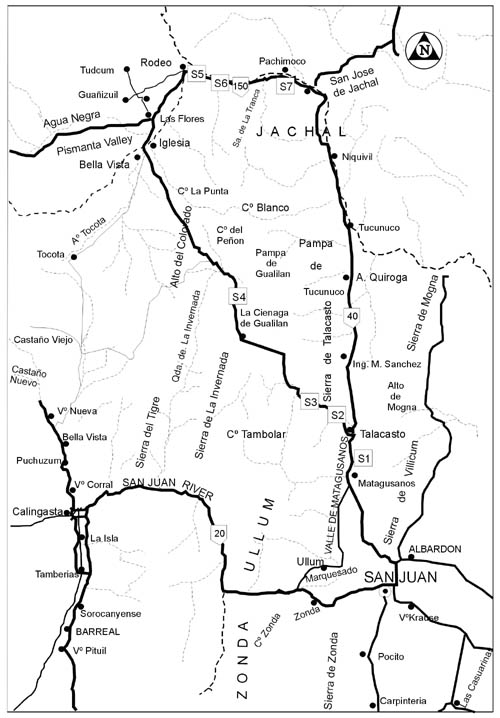
Figure 1. Map showing programmed stops for
the Talacasto–La Invernada–Jáchal River field trip.
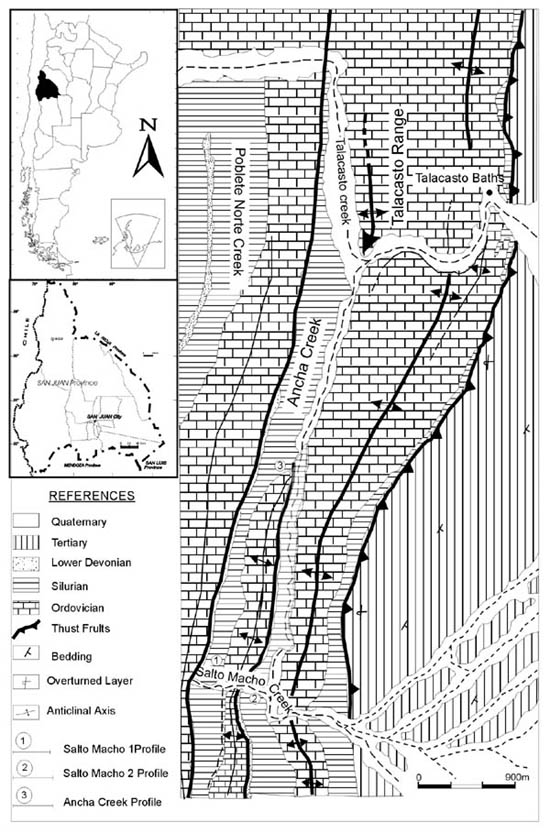
Figure 2. Map showing the geology of the Talacasto
Creek. After Baldis et al. (1984).
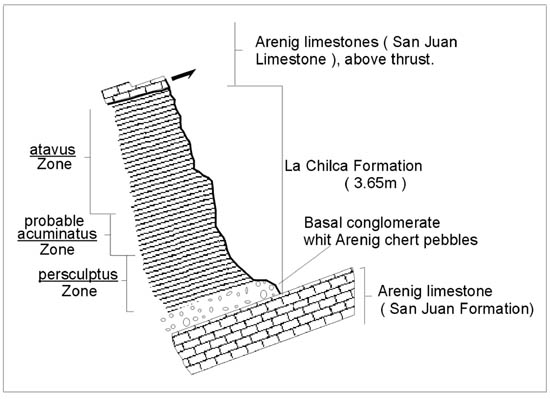
Figure 3. Stratigraphic column showing the
Ordovician–Silurian boundary from the lower part of the La Chilca Formation
at the Los Baños section.
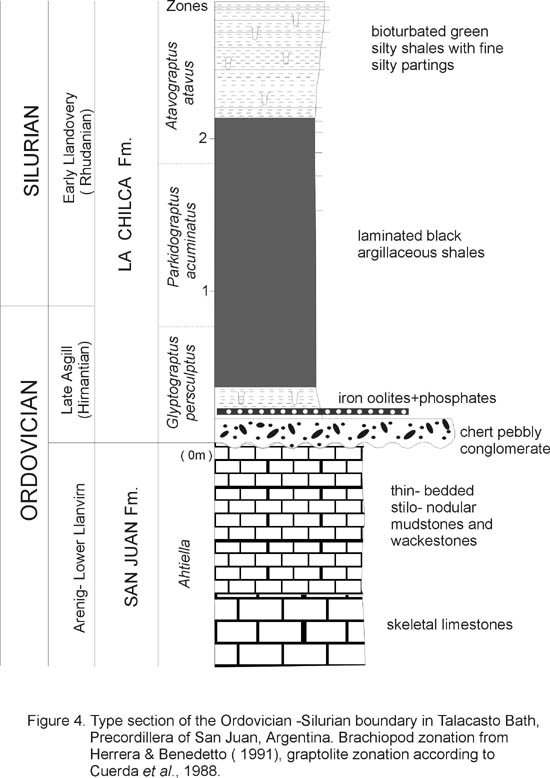
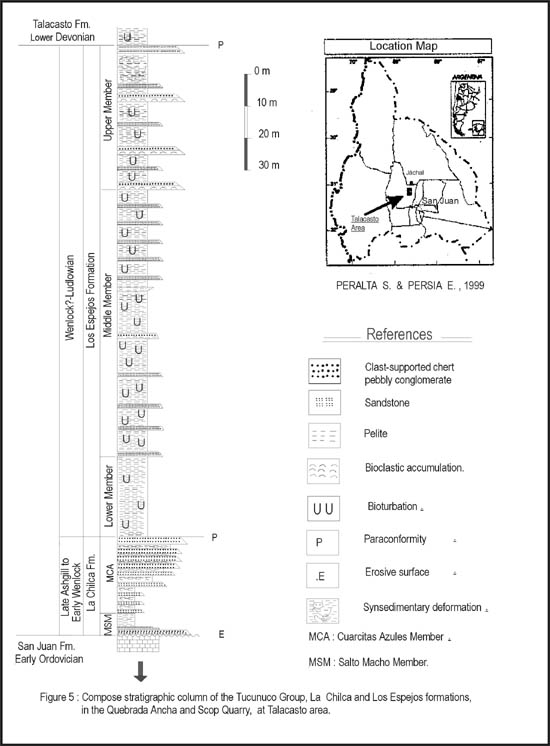
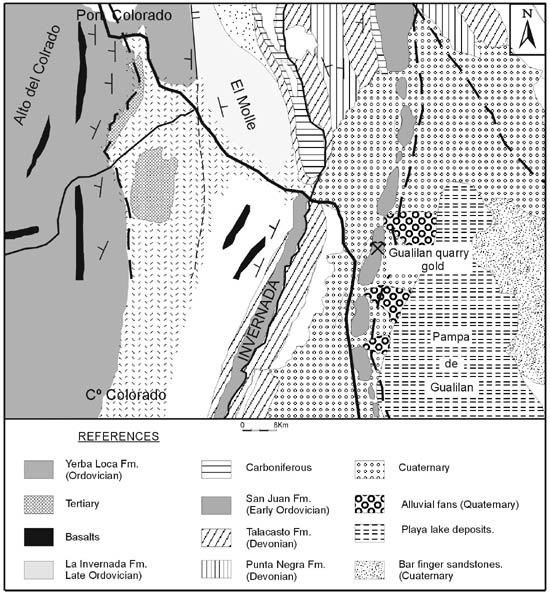
Figure 6. Map showing the geology around the
stop of the Sierra de La Invernada Formation.
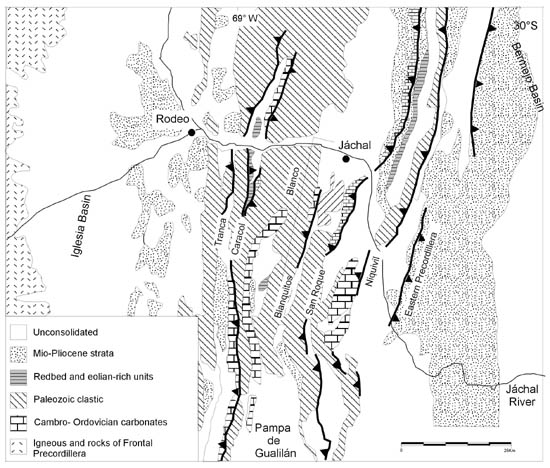
Figure 7. Map showing the geology of the Jáchal
River section. After Jordan et al. (1993)
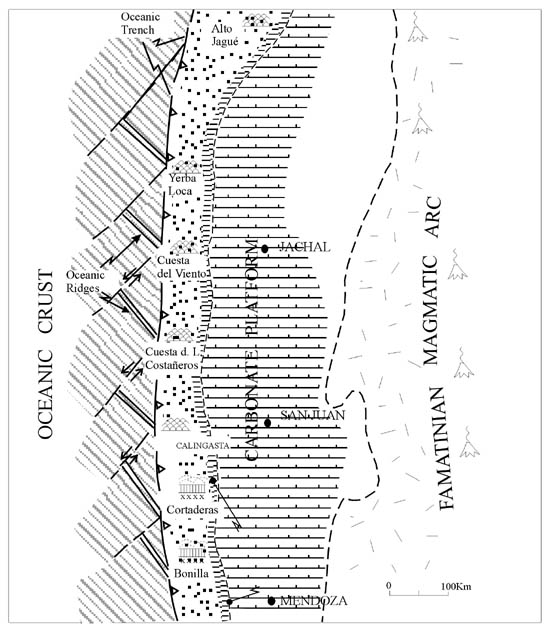
Figure 8. Geology of the Hirnantian Alcaparrosa
Formation and associated pillow lavas in the Cuesta del Viento section. Paleogeographic
and geotectonic setting of Western Precordillera. After Haller & Ramos
(1984).
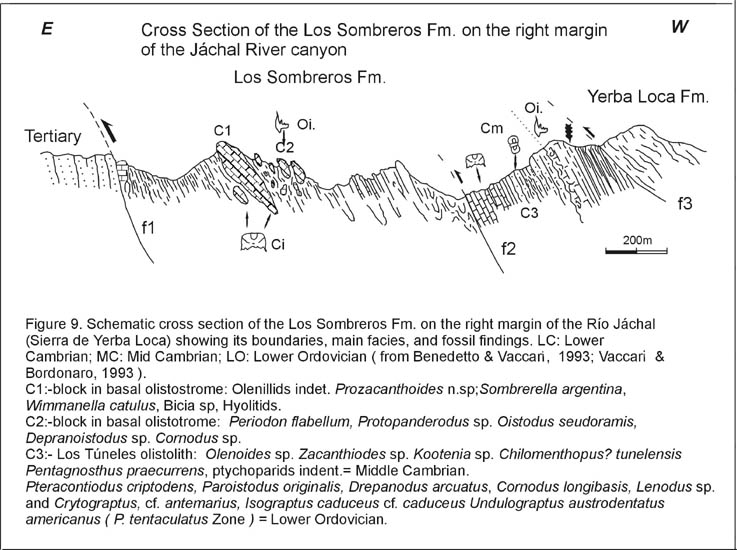
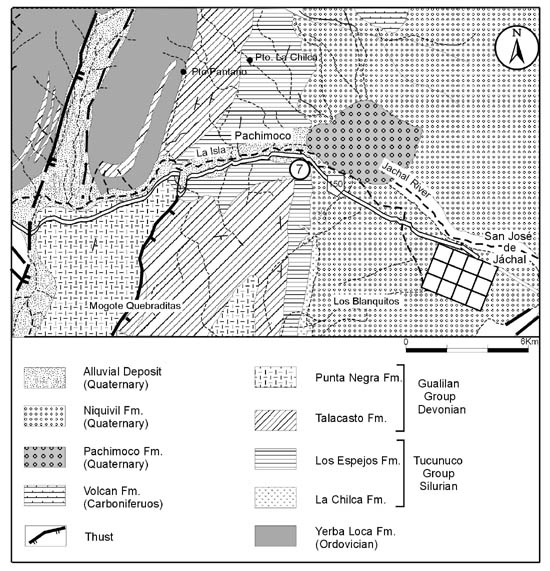
Figure 10. Map showing the geology of the
Pachimoco area. After Furque (1979).

Figure 11. Conodont assemblage from the middle
part of the Los Espejos Formation, at Ancha Creek, Talacasto area.

Fig. 12

Figure 13. Late Ashgill – early Llandovery
graptolite fauna from the lower part of the La Chilca Formation (Normalograptus
persculptus Zone, probable Parakidograptus acuminatus and Atavograptus atavus
zones), Talacasto locality, Precordillera of San Juan.
a, b, c, Talacastograptus leanzai Cuerda, Rickards & Cingolani, a, b DPI
21883; c, DPI 21879; d, e, f, Lagarograptus praeacinaces Cuerda, Rickards
& Cingolani, d, DPI 21900, e, DIP 21902, c, DIP 21903; g, Paraclimacograptus
sp., DIP 21893; h, i, Pseudoclimacograptus robustus Cuerda, Rickards &
Cingolani, h, DPI 21909, i, DPI 21910; j, k, Normalograptus medius (Törnquist),
j, DPI 21921, k, DPI 21920; l, m, Normalograptus angustus (Perner), l, DPI
21914, m, DPI 21913; n, Normalograptus normalis (Lapworth), DPI 21918; o,
p, Normalograptus persculptus (Salter), o, DPI 21896, p, DPI 21895; q, Normalograptus
acceptus (Koren’ & Mikhaylova), DPI 21919; r, Climacograptus rectangularis
McCoy, DPI 21916. All figures x7,5 except for a, g, j x5,0. Scale bar: 1 mm.
After Cuerda, Rickards & Cingolani (1988).

Figure 14. Darriwilian graptolites from the
Sierra de La Invernada Formation, San Juan Precordillera. a, d, Holmograptus
spinosus (Ruedemann); a, CEGH–UNC 872, d, CEGH–UNC 868 (after Brussa, 1999);
b, Holmograptus serpens Brussa, CEGH–UNC 868 (after Brussa, 1999); c, Xiphograptus
lofuensis (Lee), CORD–PZ 22757; e, Undulograptus austrodentatus (Harris &
Keble), CORD–PZ 22757; f, Isograptus caduceus caduceus (Salter), CORD–PZ 22757;
g, Cryptograptus antennarius (Hall), CEGH–UNC 3080 (after Brussa, 1997b);
h, Arienigraptus zhejiangensis Yu & Fang, CORD–PZ 22757; i, Paraglossograptus?
sp., CORD–PZ 22756 B; j, Tetragraptus sp., CORD–PZ 22756 B; k, Undulograptus
sinicus (Mu & Lee); l, Paraglossograptus tentaculatus (Hall), CORD–PZ
22757; all specimens x6, except for l, which is x5. Scale bar: 1 mm.

Figure 15. Stratigraphic column and graptolite
species ranges of the Sierra de La Invernada Formation (Modified from Brussa,
1996).

Fig. 16















